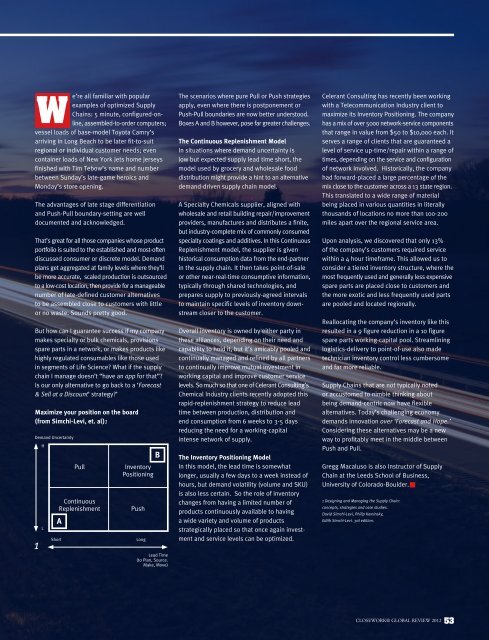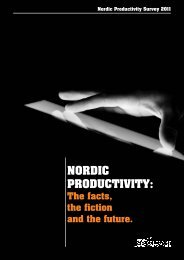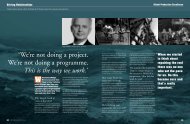download - Celerant Consulting
download - Celerant Consulting
download - Celerant Consulting
- No tags were found...
Create successful ePaper yourself
Turn your PDF publications into a flip-book with our unique Google optimized e-Paper software.
e’re all familiar with popularWexamples of optimized SupplyChains: 5 minute, configured-online,assembled-to-order computers;vessel loads of base-model Toyota Camry’sarriving in Long Beach to be later fit-to-suitregional or individual customer needs; evencontainer loads of New York Jets home jerseysfinished with Tim Tebow’s name and numberbetween Sunday’s late-game heroics andMonday’s store opening.The advantages of late stage differentiationand Push-Pull boundary-setting are welldocumented and acknowledged.That’s great for all those companies whose productportfolio is suited to the established and most-oftendiscussed consumer or discrete model. Demandplans get aggregated at family levels where they’llbe more accurate, scaled production is outsourcedto a low-cost location, then provide for a manageablenumber of late-defined customer alternativesto be assembled close to customers with littleor no waste. Sounds pretty good.But how can I guarantee success if my companymakes specialty or bulk chemicals, provisionsspare parts in a network, or makes products likehighly regulated consumables like those usedin segments of Life Science? What if the supplychain I manage doesn’t “have an app for that”?Is our only alternative to go back to a ‘Forecast& Sell at a Discount’ strategy?’Maximize your position on the board(from Simchi-Levi, et. al)1Demand UncertaintyH1LPullContinuousReplenishmentAShortBInventoryPositioningPushLongLead Time(to Plan, Source.Make, Move)The scenarios where pure Pull or Push strategiesapply, even where there is postponement orPush-Pull boundaries are now better understood.Boxes A and B however, pose far greater challenges.The Continuous Replenishment ModelIn situations where demand uncertainty islow but expected supply lead time short, themodel used by grocery and wholesale fooddistribution might provide a hint to an alternativedemand-driven supply chain model.A Specialty Chemicals supplier, aligned withwholesale and retail building repair/improvementproviders, manufactures and distributes a finite,but industry-complete mix of commonly consumedspecialty coatings and additives. In this ContinuousReplenishment model, the supplier is givenhistorical consumption data from the end-partnerin the supply chain. It then takes point-of-saleor other near-real-time consumptive information,typically through shared technologies, andprepares supply to previously-agreed intervalsto maintain specific levels of inventory downstreamcloser to the customer.Overall inventory is owned by either party inthese alliances, depending on their need andcapability to hold it, but it’s amicably pooled andcontinually managed and refined by all partnersto continually improve mutual investment inworking capital and improve customer servicelevels. So much so that one of <strong>Celerant</strong> <strong>Consulting</strong>’sChemical Industry clients recently adopted thisrapid-replenishment strategy to reduce leadtime between production, distribution andend consumption from 6 weeks to 3-5 daysreducing the need for a working-capitalintense network of supply.The Inventory Positioning ModelIn this model, the lead time is somewhatlonger, usually a few days to a week instead ofhours, but demand volatility (volume and SKU)is also less certain. So the role of inventorychanges from having a limited number ofproducts continuously available to havinga wide variety and volume of productsstrategically placed so that once again investmentand service levels can be optimized.<strong>Celerant</strong> <strong>Consulting</strong> has recently been workingwith a Telecommunication Industry client tomaximize its Inventory Positioning. The companyhas a mix of over 5000 network-service componentsthat range in value from $50 to $10,000 each. Itserves a range of clients that are guaranteed alevel of service up-time/repair within a range oftimes, depending on the service and configurationof network involved. Historically, the companyhad forward-placed a large percentage of themix close to the customer across a 13 state region.This translated to a wide range of materialbeing placed in various quantities in literallythousands of locations no more than 100-200miles apart over the regional service area.Upon analysis, we discovered that only 13%of the company’s customers required servicewithin a 4 hour timeframe. This allowed us toconsider a tiered inventory structure, where themost frequently used and generally less expensivespare parts are placed close to customers andthe more exotic and less frequently used partsare pooled and located regionally.Reallocating the company’s inventory like thisresulted in a 9 figure reduction in a 10 figurespare parts working-capital pool. Streamlininglogistics-delivery to point-of-use also madetechnician inventory control less cumbersomeand far more reliable.Supply Chains that are not typically notedor accustomed to nimble thinking aboutbeing demand-centric now have flexiblealternatives. Today’s challenging economydemands innovation over ‘Forecast and Hope.’Considering these alternatives may be a newway to profitably meet in the middle betweenPush and Pull.Gregg Macaluso is also Instructor of SupplyChain at the Leeds School of Business,University of Colorado-Boulder.1 Designing and Managing the Supply Chain:concepts, strategies and case studies.David Simchi-Levi, Philip Kaminsky,Edith Simchi-Levi. 3rd edition.CLOSEWORK® GLOBAL REVIEW 2012 53








